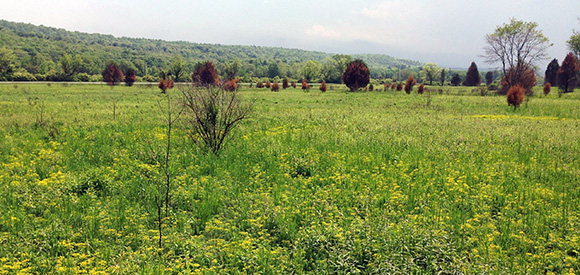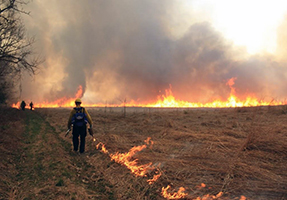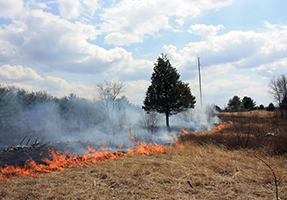In 2014 Delaware Water Gap National Recreation Area used prescribed fire to treat 800 acres across 12 burn units to maintain open space, reduce hazardous fuels, and restore the cultural landscape. The burn also contributed to the park’s natural resource management goal to provide early successional habitat for grassland birds such as bobolink and grasshopper sparrows, various insect species, and upland game bird species such as wild turkey.

NPS / M. Boss
Open Space

NPS / T. Liogys
Delaware Water Gap National Recreation Area (NRA) manages 70,000 acres of land. Approximately 3,000 of these acres are actively managed in the open space program. During April and May 2014, Delaware Water Gap NRA used prescribed fire to treat 800 acres across 12 burn units to maintain open space, reduce hazardous fuels, and restore the cultural landscape as addressed in the park’s enabling legislation. The burn also contributed to the park’s natural resource management goal to provide early successional habitat for grassland birds such as bobolink and grasshopper sparrows, various insect species, and upland game bird species such as wild turkey.
Currently at Delaware Water Gap NRA, the open space management regime includes multiple management methods: an agricultural special use permit program, mechanical treatments with volunteer assistance, selected treatments by the National Park Service’s Exotic Plant Management Team from the Northeast Region, and prescribed fire. In the future, the use of prescribed fire as a management tool will likely increase as interest in agricultural permits drops.
Historic Farm Fields

NPS / T. Liogys
Most of Delaware Water Gap NRA’s units available for prescribed fire treatment are historic farm fields, some farmed or maintained as open space for almost a thousand years. Left without treatment these areas would quickly transition from grasslands to brush and finally forest. Invasive plants would rapidly encroach on these open spaces as well without combined treatments. The park continues to adaptively refine the timing of treatments to find the best mix of treatment methods over time.
The project was completed safely and provided opportunities for multiple agencies to train and increase their wildland fire response efficiencies. Fire resources came from across the Northeast Region: Gateway National Recreation Area, Upper Delaware National and Scenic River, Statue of Liberty National Monument, Steamtown National Historic Site, USDA Forest Service (Grey Towers), New Jersey Forest Fire Service and Pennsylvania Bureau of Forestry.
Contact: Cliff Lively, fire management officer, Mid-Atlantic Fire Management Area
e-mail us
Phone: (570) 588-1845
Tags
- delaware water gap national recreation area
- wildland fire
- cohesive strategy
- maintain and restore resilient landscapes
- fy2014
- prescribed fire
- fuel reduction
- natural resource management
- maintain open space
- cultural landscape restoration
- habitat restoration
- facilities safety
- life safety
- ner
- northeast
- pennsylvania
- new jersey
Last updated: December 14, 2016
